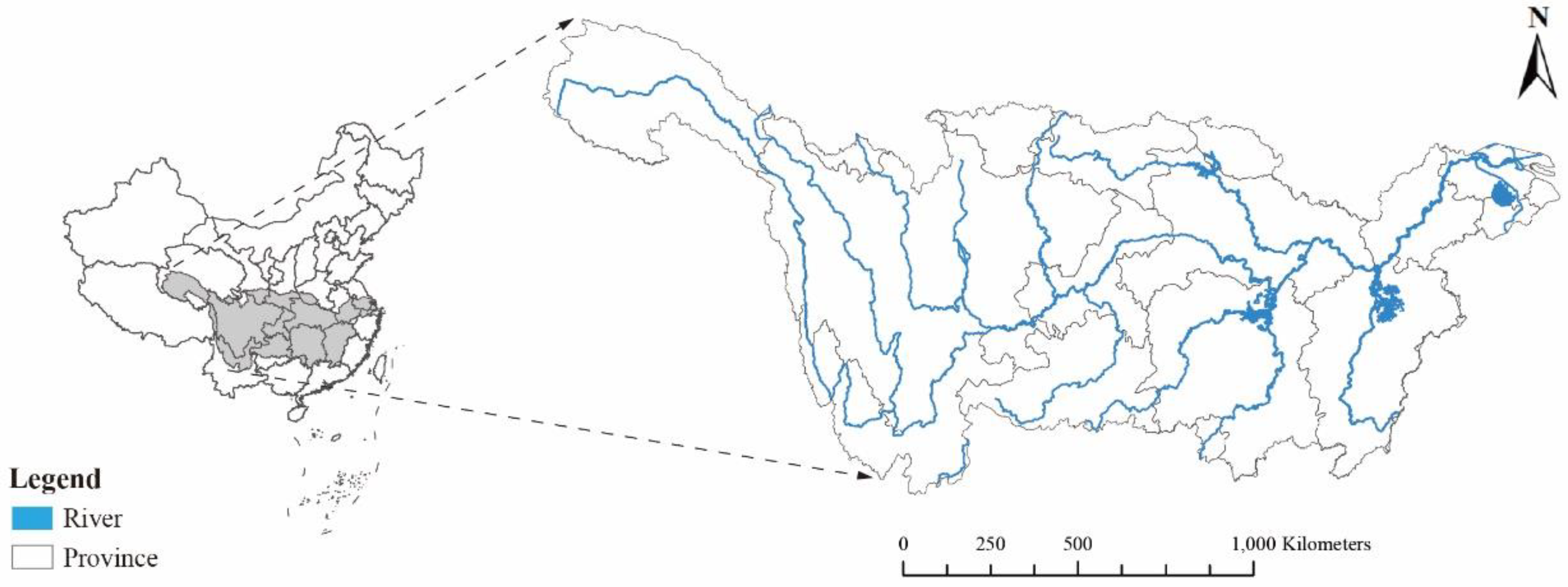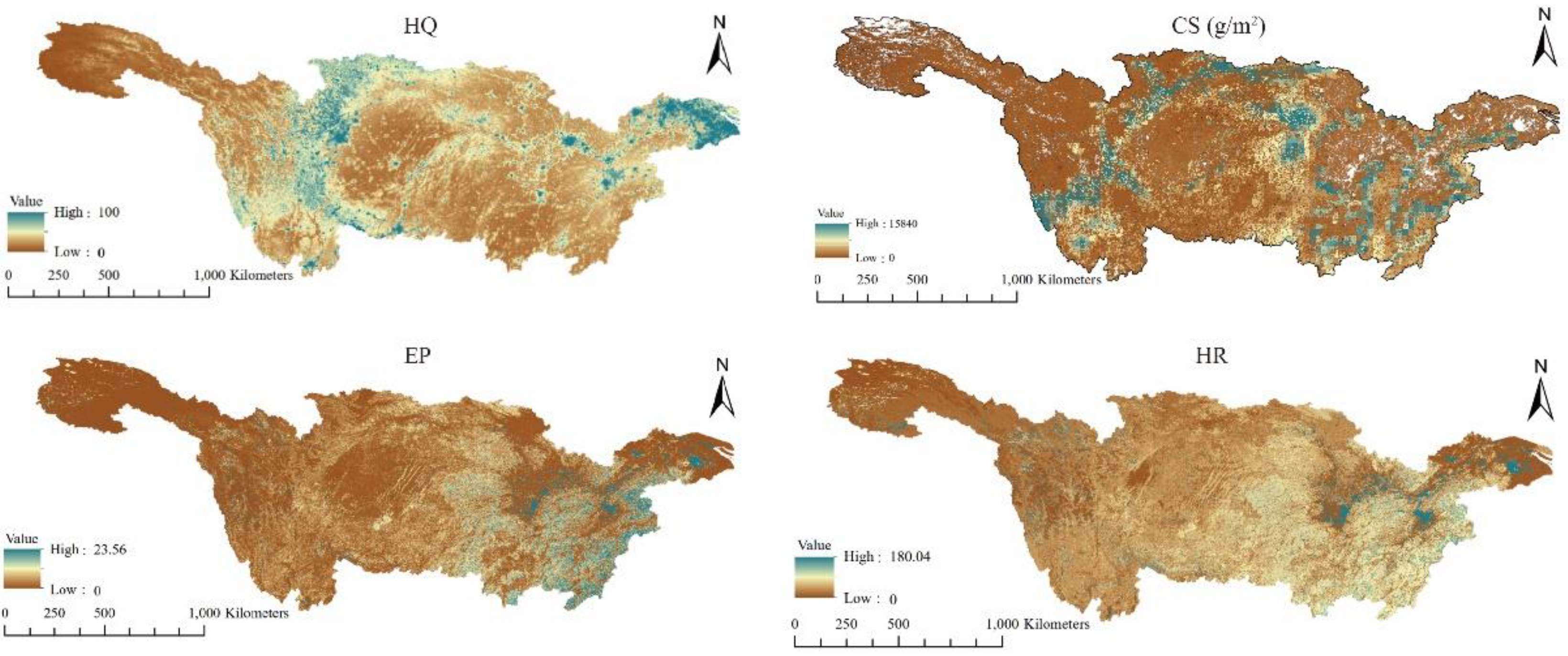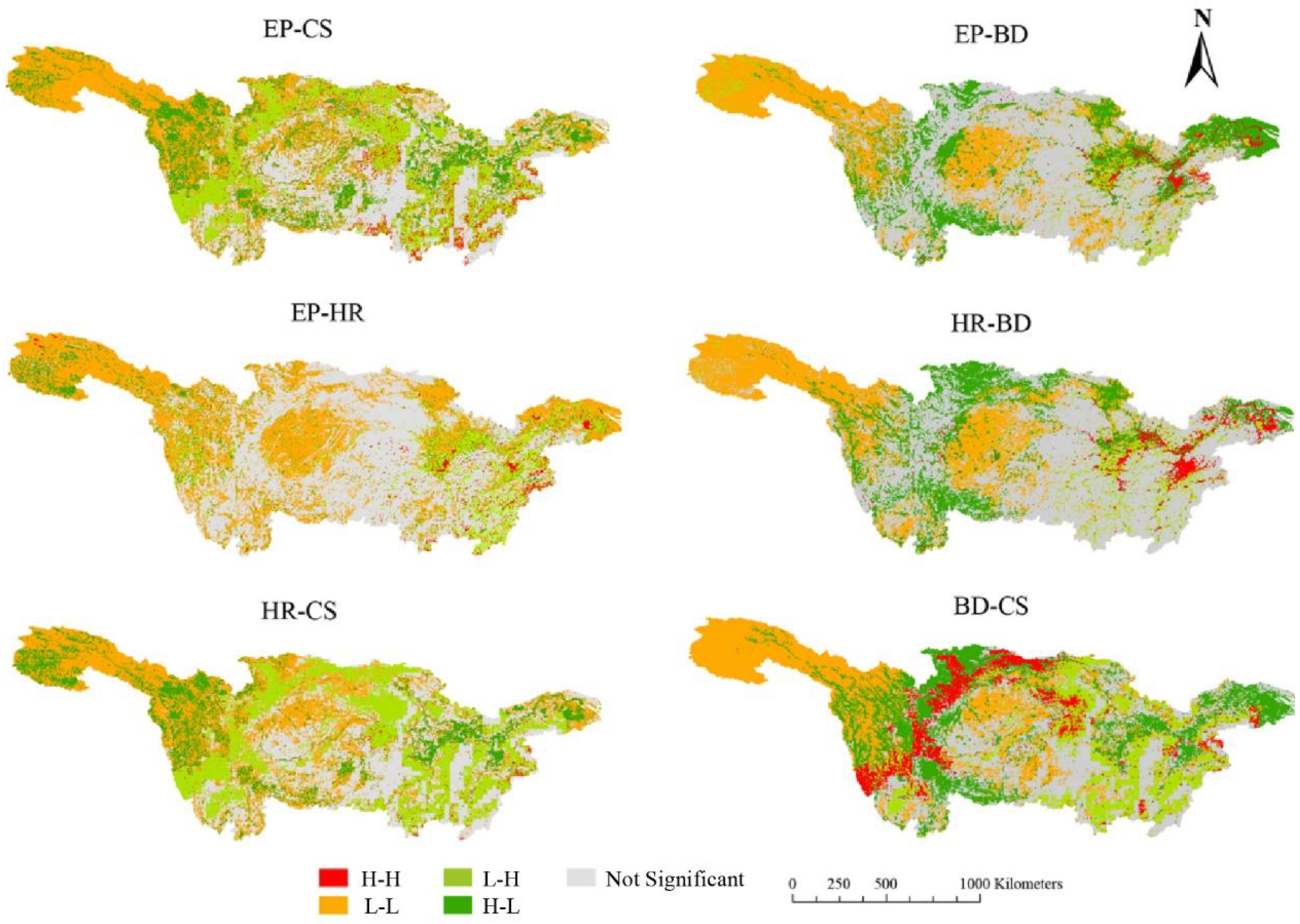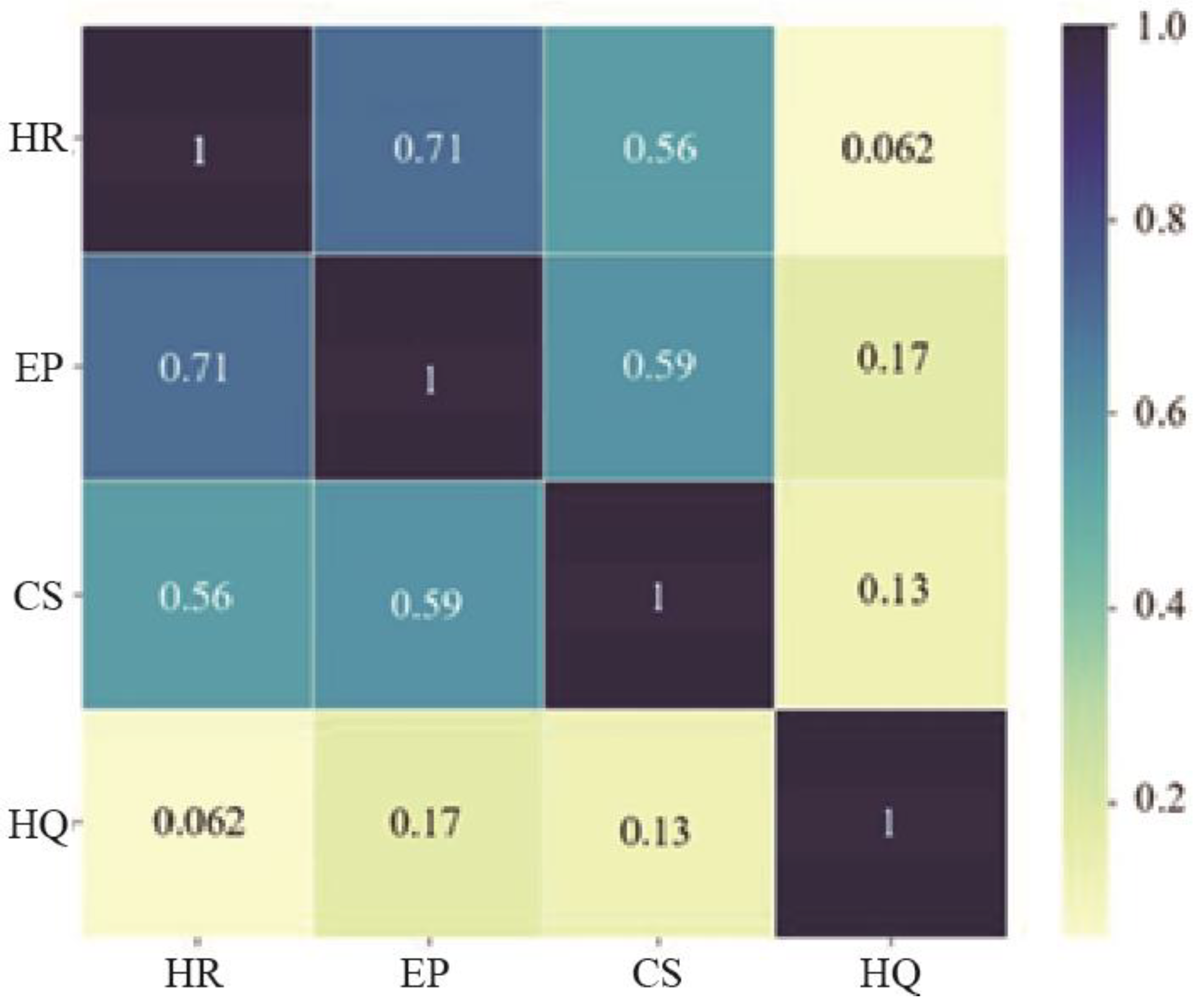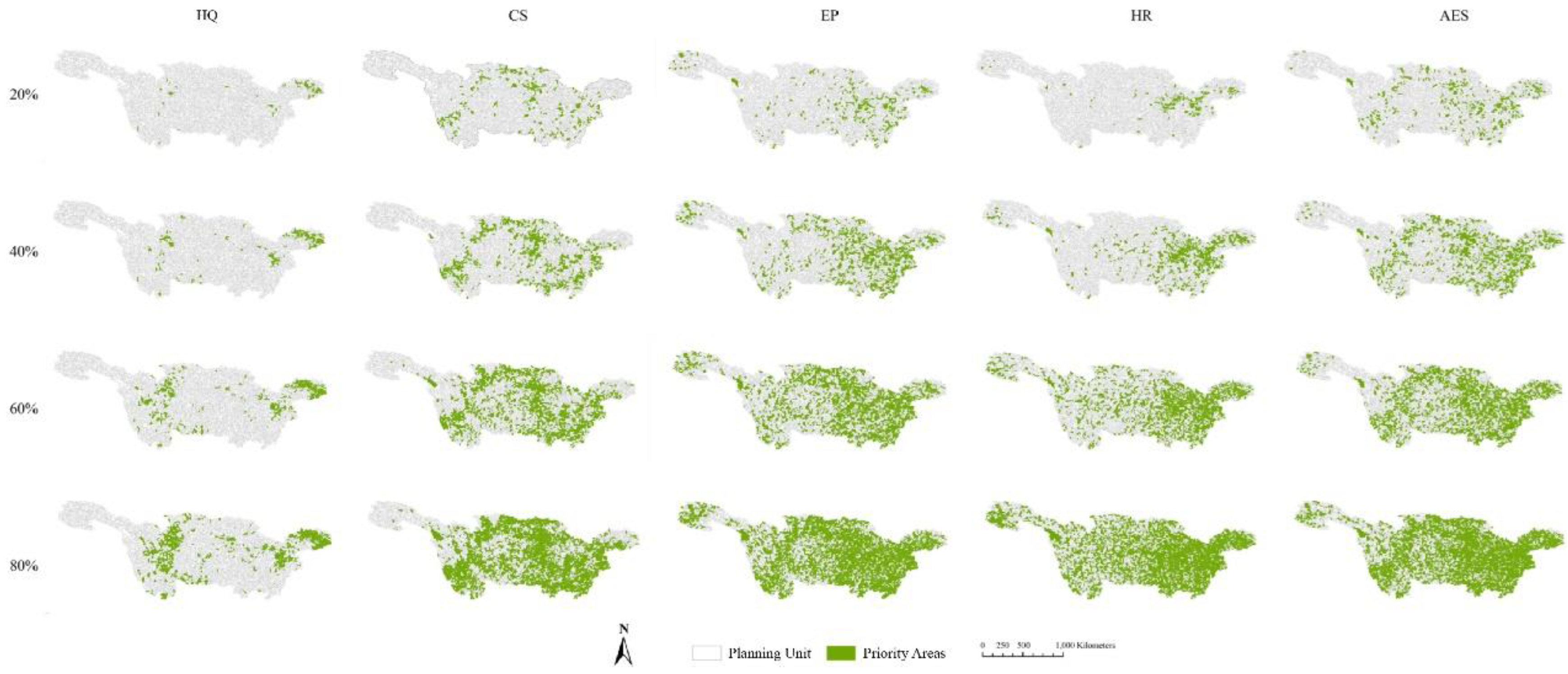1. Introduction
Ecosystem services are various direct or indirect positive benefits of nature to people, which can be categorized by the Millennium Ecosystem Assessment (MEM) to provisioning, regulating, cultural and supporting services (Millennium Ecosystem Assessment, 2003). Ecosystem services are increasingly being in destruction and threat due to utilitarian consumption of natural resources (Steffen et al., 2015; Sutton et al., 2016). Biodiversity has long been the uppermost concerns in the conservation planning, until the last decade or two (Dudley, 2008; Boulton et al., 2016), high-value ecosystem service areas become be attached importance to be enhanced (McCann, 2000; Balvanera et al., 2001; Chan et al., 2006). Researchers calls for that ecosystem services should be included in conservation planning (Egoh et al., 2007; Reyers et al., 2012). The Kunming-Montreal Global Biodiversity Framework also reached an agreement over a target of not less than 30% of the world’s terrestrial, freshwater and marine areas, with significant value of biodiversity and ecosystem service should be maintained in effective conservation and management (
https://www.un.org/).
Conservation planning uses customized rules to identify optimal geographic areas of conservation features with important natural resource values. The efficacy of conservation planning lies in that achieving conservation goals under restricted range of conditions (Margules et al., 2000; Juutinen et al., 2008). The fundamental mathematical theory of conservation planning is tackling the problem of maximal coverage or minimal set problem, which is to meet the target to the greatest extent and takes the cost as few as possible in the meanwhile (Harrington et al., 2010; Williams et al., 2020). Several popular conservation planning theories have been put forward since the early 1880s (Wang, 1989; Guo et al., 2013). The representative methods are Biogeographic Regionalization, which divides the regions into several similar or identical units by attributes of topographic, hydrology, temperature, soil, etc. (Zheng et al., 2005), and Hotspot tries to protect the areas with high species richness, which raises the probability of species with maximal element cooccurrence being included (Myers, 1990). With few exceptions, the commonness of these methods exclusively counts on the high-value areas, where the species are either high in amounts or diversity. Though most of the valuable areas are taken seriously, some rare or endemic species would be missed in the final planning (). To make for the disadvantages, Systematic Conservation Planning (SCP) carries out the planning with principles of representativeness, complementarity, and persistence, which provides the foundation to achieve the conservation goals comprehensively and efficiently (Margules et al., 2000). Widespread successful practices have been implemented using SCP around the world to look up for additional areas from the existing reserve networks or design brand new portfolio of protected areas.
Conserving ecosystem services is not a full copy of conserving biodiversity. Ecosystem services have two unique characteristics that different from biodiversity. One is that the measure value for ecosystem service is continuous variables while the measure value for biodiversity is discrete variables, traditional biodiversity goals is a count number of species while ecosystem service values is measured that can be subdivided, ecosystem services are poor in movability and consecutive distribute in spatial compare to biodiversity, integrity are more weighted in the conservation planning. Another is that interactions of trade-offs and synergies exist among different ecosystem services (Harrison et al., 2014), preserving one ecosystem service would at the expense of disregarding for the others (Li et al., 2022). Likewise, exploring the correlations between habitat quality (biodiversity) and other ecosystem services is one of the focus points in the present researches (Cardinale et al., 2012; Mouchet et al., 2014; Lamarque et al., 2014), their opinions are divergent in the spatial congruence, the relationships are supposed to be positive or negative (Harrison et al., 2014; Ricketts et al., 2016; Watson et al., 2019). Given this case, it would be tough or meaningless to strive for the correlations than quantifying and optimizing the ecosystem services with SCP. One of the reasons is that most studies capture the relationships of ecosystem services with the total value of the entire study areas. In fact, spatial heterogeneity is apparent in ecosystem services, conclusions may vary with different scales. Explicit calculation of the spatial correlation among ecosystem services is an essential prerequisite for figuring the conservation planning with the trade-offs and synergies considerations.
To sum up, we focused on the Yangtze River Basin (YRB) as a case study of conservation planning for ecosystem services. We first estimated the four ecosystem service (habitat quality, carbon storage, environmental purification and hydrological regulation) values in the YRB, then we analyzed the trade-offs and synergies in spatial among all the ecosystem services, at last, we compared the optimal spatial pattern of conservation for each ecosystem services and attempted to conserve the maximum benefits of multiple ecosystem services in a more efficient ways with the guidance of SCP, setting targets of various scenarios enable us to comparatively weigh the potential benefits of multiple plans in details. Our presented results could be served for mangers to launch policies for management.
2. Materials and Methods
2.1. Study Area
The Yangtze River Basin (24°30′~35°45′ N, 90°33′~122°25′ E) (YRB,
Figure 1) is an area of approximately 1.8 × 10
6 km
2 that extends by the Yangtze River, which is the third longest river in the world, with a length of 6300 km. The Yangtze River sources from the Plateau of Tibet and flows into the East China sea, it traverses 19 provinces and 3 economic zones. The YRB stretches with varied climate, landforms and ecosystems, and the elevation drops between the top and bottom is about 5000 m. The average temperature is -4 °C in the upper YRB, whereas is 4 °C~20 °C in other regions. The precipitation is largely influenced by the monsoon and landform, the annual average is 400 mm ~ 800 mm and is uneven in both spatial and seasons. The YRB has more than 7000 tributaries, contributing 35% of the total water resources in China, which is much higher than other basins.
2.2. Data Sources
This study evaluated the ecosystem services of habitat quality, carbon storage, environmental purification and hydrological regulation. The habitat quality was estimated with the Maxent model, the species distributions data were downloaded from IUCN (United for Life & Livelihoods,
https://www.iucn.org) and GBIF (Global Biodiversity Information Facility,
https://www.gbif.org), the weather and climate data were from the WorldClim (
https://www.worldclim.org) with a spatial resolution of 30 seconds.The carbon storge was calculated with the inversion equation, in which the NDVI was downloaded from the GIMMS Global Agricultural Monitoring (
https://glam1.gsfc.nasa.gov) and the vegetations was from the Geographic data platform of Peking University (
https://geodata.pku.edu.cn). The environmental purification and hydrological regulation were estimated the LULC data that obtained from the RESDC (Resources and Environment Science and Data Center,
https://www.resdc.cn) with 1000-meter resolution in 2020, and the NPP (Net Primary Production) and precipitation data were obtained from the Geospatial Data Cloud (
https://www.gscloud.cn/). The subcatchment data served as planning unit was from the BasinATLAS (
http://www.hydrosheds.org).
2.3. Estimation of Ecosystem Service Values
2.3.1. Habitat Quality
The habitat quality was assessed with the Maxent (version 3.4.3) software, which using the maximum entropy algorithm to rating the niches for species. The results were species occur probabilities that computed by a function of a set of environmental factors. The threatened species are generally employed as surrogate for biodiversity for data scarce areas, we thus choose the list of threatened species from IUCN red list in China, which include mammals, amphibians and freshwater groups. The localities for each species were from GBIF, to raise the generalization performance of Maxent, we dropped the species that recorded in GBIF with the number of occurrences that lower than 30. We selected 20 environmental factors to model the niches of the species, 19 were from the WorldClim (details on the factors could be seen on the website of WorldClim), one was LULC.
2.3.2. Carbon Storage
In this study, the carbon storge was for vegetations, which consist of the aboveground and belowground carbon storage. The method to estimate the carbon storage was based on Fang (2007). The aboveground carbon storage was calculated with an inversion function that related the NDVI and the biomass. The belowground biomass can be calculated using ratio of the belowground and aboveboard biomass in terms of the type of the vegetation (Fang et al., 207), this was also true to convert the biomass to carbon storage with a conversion factor, we classified the vegetation into forest, shrub, grassland, cropland and marsh in our study.
2.3.3. Environmental Purification and Hydrological Regulation
We used an improved equivalence factor method to estimate the ecosystem services values of environmental purification and hydrological regulation followed by Xie (2015). The method first evaluates the value equivalence factor in per hectare for 14 different types terrestrial ecosystem, then using the dynamic spatio-temporal modifier to be as reflections of the variations of each type of ecosystems, the formulas were as follows:
where
Fij is the equivalence value of environmental purification/hydrological regulation in month
j of the area
i;
Fn is the equivalence factor of ecosystem services types;
Bij is the NPP/precipitation in month j of area i,
B is the annual average value of NPP/precipitation, NPP is the modifier of environmental purification and precipitation is the modifier of the hydrological regulation; the ecosystem service equivalent value per unit area is based on Xie (2015).
2.3.4. Relationships analysis among ecosystem services
The Local Moran’s I was applied to determine the trade-offs and synergies of the paired ecosystem services out of 4, which makes classification of 5 kinds of cluster against the concentration of values by their similarity, they are high-high (HH), low-high (LH), low-low (LL), high-low (HL) and not significant (NS). The formula was as follows:
where
I is the Local Moran’s I, the value ranges from -1 to +1, -1 indicates they are negative correlativity, +1 indicates they are positive correlativity, 0 indicates they are unrelated;
Wij is a weights matrix that represents the spatial configuration of the unit value of the raster data;
i and
j is the type of ecosystem services;
x is the ecosystem service value of the cell while
x is the average value of all units. The Local Moran’s I was computed in GEODA (version 1.16).
2.4. Estimation of Ecosystem Service Values
We used MARXAN (version 1.8.2) to find best areas for ecosystem services conservation, which is a conservation protected areas design software based on rules of SCP (Ball, 2009). MARXAN solutes the problem of the minimum set, that is a set of elements could realize utmost representativeness of the target with the least cost. In this study, we divided the YRB into 6828 subcatchments (the average area is 246.21 km
2) as the element of planning unit, each with the conservation features (ecosystem services values) and the cost. Computationally, it applies ‘0-1’ integer programming model to fit the problem,
where
xi is the planning unit
i, in the result,
i is either 0 for unselected or 1 for selected;
ci is the cost of the planning unit
i; b is the boundary length modifier, which is used to modify the compactness of the selected planning unit, the higher of the value, the clump size of the solution was larger;
cvih was the length of the shared boundary of planning unit
i and
h;
rij is the value of feature
j in planning
i,
Tj is the target for feature j, in our study, we set targets to conserve 10% to 80% of each and all ecosystem services. MARXAN runs with the simulated annealing algorithm to solve the equations.
2.5. Measurement of the similarity between optimal spatial patterns
Jensen-Shannon divergence (JSD) was employed to measure the similarity of optimizing different ecosystem services, the results of MARXAN is an ordered array consisted of 0 and 1, we run MARXAN 1000 times and calculated the probability of being selected for each unit to generate an array of probability distribution, thus their similarity of distribution could be measured by JSD, the formula was as follows,
where P(X) and Q(X) is the probability distribution of optimizing each target, the values of JSD ranges from 0 to 1, 0 means that the two distributions are identical and 1 means that the two distributions are totally different.
3. Results
3.1. Distribution and trade-offs of ecosystem services supply areas
The distribution for habitat quality was clustering, in the plenty lakes and river regions. High value areas of habitat quality were in the 3 biggest lakes along the Yangtze River (
Figure 2), which were Dongting Lake, Poyang Lake and Tai Lake, besides, there were also areas eminently suitable for species to survival scattered in the downstream of the Jinsha River. The forest, shrubland and grassland were the most import contributor to carbon storage, the distribution of carbon storage therefore showed a situation of northeast was high and southwest was low, this was also coincided with the distribution of the Yangtze River Economic Belt, urbanization would encroach the natural land of forest and grassland. The spatial characteristics of environmental purification was roughly opposite to that of carbon storage, showing mid-west was low and east was high. Similarly, environmental purification was very low in the Yangtze River Delta, where the human interference development intensity was extremely high. Hydrological regulation was directly related with the water resources, they were distributed in the regions of rivers and lakes.
The overall performance of Local Moran’s I map (
Figure 3) showed that there was positive correlation between 4 ecosystem services occupied large areas in the Yangtze River. Large areas of H-H agglomeration were exclusively existed between HP and CS, they were in the junction regions between the upstream and midstream of the Yangtze River. The H-H agglomeration areas of EP and HQ, HR and CS were mainly distributed in the lower reaches of the Yangtze River. The synergies of H-L agglomeration were significant for all ecosystem services in the midstream of the Yangtze River. EP and HP, HP and CS presented a homologous distribution of L-L agglomeration, this was also true for EP and CS, HR and CS. Obvious areas of L-H agglomeration could be observed in the upper-middle reaches and delta of the Yangtze River.
3.2. Priority areas for ecosystem services conservation
Setting target for conserving each ecosystem services, the priority areas varied not the same under different target level, which was particularly prominent at the target of 20%. As the target level increased, priority areas of CS, EP and HR became to be coincident with each other while nearly half of the HQ priority areas were not complied with (
Figure 4). This was due to the high HQ values areas were not consistent with other three ecosystem services. Only EP and HR appeared a similar trend in the optimal spatial conservation pattern, these areas were concentrated in the east and source of the Yangtze River Basin. When conserving all the ecosystem services, the priority areas were not merely an overlap of the results of optimizing each four ecosystem services, trade-offs were obvious between optimizing HR and optimizing all ecosystem services, their JSD was 0.67, 0.61 0.48 and 0.44 in order under target level of 20%, 40%, 60% and 80% (
Figure 4). MARXAN tried to find the best solutions under principles of representativeness and complementarity, areas with high values of all target features would have higher priority, then high value areas with single feature were included. Another reason for this was that the value distribution of HQ was uneven, less areas possessed much of the total amount, the same is true for CS, the value distribution for EP and HR were relatively uniform, so that their priority areas were quite different under a low target level but became more similar as the target level increased (
Figure 5).
4. Discussion
Our study proposed employing SCP theory to optimizing ecosystem services conservation in an efficiency way with the consideration of their trade-offs and synergies. We evaluated the distribution of the HQ, CS, RP and HR in the Yangtze River basin quantitatively, and then analyzed their incompatible of trade-offs and synergies in spatial. The measurement of JSD between each ecosystem services allowed us to find out the discrepancy in the optimal conservation solutions. Undoubtedly, conservation planning under different target setting will produce multiple spatial optimal configurations with more or less different. Every time drawing up the planning that aims at each objective and overlay the results together will be in low efficient with much more cost in areas, time and monetary. We thus introduced the principles of representativeness and complementarity, making SCP for optimizing multiple ecosystem services comprehensively to balance the trade-offs among these conservation features based on multi-scenarios., which could provide preferential focal areas for their co-benefits to conservation and improve the regional sustainability for managers to develop strategy in one time.
A numerous of research have been conducted on the trade-offs and synergies of ecosystem services, however, they predominantly interested in the spatial relationships, the driving factors, the dynamic spatial and temporal changes of ecosystem services, which areas have higher priorities to be protected are few discussed. In order to raise the accuracy of the trade-offs analysis, we used MaxEnt to evaluate the suitability of biodiversity, and NDVI, NPP, precipitation as an adjustment layer to reflect the heterogeneity of the same land-use type, land-use is a key factor determining ecosystem services themselves. Similarly, ecosystem service value estimation models such as InVEST, CASA employs topographical, metrological or soil types data as the correction factors. Even though, limited by the accessibility, scale and time sequential of the data, the evaluation of the values of the same land-use type and different years are commonly homogenization, which means that as long as the land are not be transformed, their ecosystem service values would not be changed (Kremen, 2005; Lin et al., 2017). In addition, we used Local Moran’s I to seek the relationship among ecosystem services, which is widely used in the field of economic (Wang et al., 2015). Different from the largely used Spearman’s correlations method, our method takes the weight of the area that close to the target computing unit into account, which could be applied to a high-resolution dataset and mapped the results into space, the results also had more details that they were classified into 5 kinds of cluster (e.g., HH, LH, LL, HL, NS). Ignoring the spatial proximity when calculate the correlations of ecosystem service values would share the unit with maximum or minimum values with the whole region that lead to an underestimate or overestimate of its trade-offs and synergies (Reside et al., 2017).
Marxan as a decision support tool is mostly and extensively used in creating protected area systems aimed at conserving biodiversity or biodiversity surrogate (Ball et al., 2000), which including character or trait diversity, species diversity, species assemblage, landscape pattern and life-zone diversity. SCP has been proved to be the best practice in biodiversity conservation, nonetheless, being put on a conservation planning of ecosystem services are rare. In common sense, areas with the highest ecosystem service values areas should be selected, a typical and well-known area-selection method that follow the concept is hotspots, hotspots focus on choosing richness or range-size rarity in spices of areas. Case studies show that the overlook of making rules from the perspective of conserving all the whole species will lead to that some of the species escape from all the species of the region in the final solution when the target level is not high, and more areas and economic cost would be needed. Further, our results also showed that a comprehensive planning for all the ecosystem services were more efficient than optimizing each of them. This is in part because the planning aiming at a single objective merely count on its high value areas but not the co-benefits areas with others (Hermoso et al., 2020). In recent years, the Chinese government has embarked on reform of territorial spatial planning, one of its core notions is multi-plan integration, for instance, drawing the farmland redline, protected areas redline and urban development boundary on a same map to reconcile their benefits and conflicts. Our study could provide good enlightenment for the planning at a national scale.
Our study still has some limitations, though we compared the trade-offs and synergies among ecosystem services, other correlations were not analyzed, such as the demand and flow (Bagstad et al., 2013; Villarreal-Rosas et al., 2020). Basically, the beneficiaries of ecosystem services are people and nature, efficiency will go a step further if the flow paths between the demand areas and supply areas were identified, it spends extra loss and cost in long-distance transmission (Goldman et al., 2008). Moreover, we didn’t incorporate the restoration planning, high ecosystem service value areas could be restored by the ecological restoration projects, and the Chinese government are also implementing policies of ecological protection and restoration of mountains-rivers-forests-farmlands-lakes-grasslands. From the view of this prospect, our study proposed that governments, stakeholders and mangers should be involved together to develop strategies of conservation and restoration, the trade-offs in meeting their goals are crucial in a systematic planning. A comprehensive planning is more sustainable than piecing together multiple separate planning.
5. Conclusions
There are trade-offs and synergies among ecosystem services, conservation planning that aimed at protecting different objectives would inevitably involves conflicting in priority areas. However, to the best of our knowledge, most other conservation priority studies only focused on a single objective, which would result in problems once it is implemented in practice, the following another planning has to draw up strategies based on the predetermined protection patterns. Traditional conservation planning strategies prefer to protecting high-value areas of conservation features, in this case, the entire areas are gradually occupied by one planning after another. We estimated four ecosystem service values in the Yangtze River Basin and analyzed their correlations spatially at a local scale, the cluster of ecosystem service values were heterogeneity in spatial. By setting multiple scenarios, we found it was unwise to superimpose multiple plans of optimizing targets, an integrated planning was more efficient in taking less areas with equal return of benefits.
Author Contributions
Conceptualization, Y.M., X.L. and J.W.; methodology, Y.M.; software, Y.M.; validation, Y.L. and J.L.; M.S. drafted the manuscript and J.W. and C.Z. was responsible for manuscript review;. All authors have read and agreed to the published version of the manuscript.
Funding
This research received no external funding.
Institutional Review Board Statement
Not applicable.
Informed Consent Statement
Not applicable.
Data Availability Statement
Not applicable.
Acknowledgments
A special acknowledgment should be expressed to the Beijing Normal University that supported the implementation of this study. We also thank anonymous reviewers for their constructive comments on the manuscript.
Conflicts of Interest
The authors declare no conflict of interest.
References
- Archibald, C. L., Dade, M. C., Sonter, L. J., Bell-James, J., Boldy, R., Cano, B., ... & Rhodes, J. R. (2021). Do conservation covenants consider the delivery of ecosystem services?. Environmental Science & Policy, 115, 99-107. [CrossRef]
- Bagstad, K. J., Johnson, G. W., Voigt, B., & Villa, F. (2013). Spatial dynamics of ecosystem service flows: a comprehensive approach to quantifying actual services. Ecosyst. Serv. 4, 117–125. [CrossRef]
- Ball, I.R., Possingham, H.P., 2000. MARXAN (V1.8.2) User’s Manual. http://www.ecology.uq.edu.au/marxan.html.
- Balvanera, P., Daily, G. C., Ehrlich, P. R., Ricketts, T. H., Bailey, S. A., Kark, S., ... & Pereira, H. (2001). Conserving biodiversity and ecosystem services. Science, 291(5511), 2047-2047. [CrossRef]
- Boulton, A. J., Ekebom, J., & Gislason, G. M. (2016). Integrating ecosystem services into conservation strategies for freshwater and marine habitats: a review. Aquatic Conservation: Marine and Freshwater Ecosystems, 26(5), 963-985. [CrossRef]
- Cardinale, B. J., Duffy, J. E., Gonzalez, A., Hooper, D. U., Perrings, C., Venail, P., ... & Naeem, S. (2012). Biodiversity loss and its impact on humanity. Nature, 486(7401), 59-67.
- Chan, K. M. A., Shaw, M. R., Cameron, D. R., Underwood, E. C., & Daily, G. C. (2006). Conservation planning for ecosystem services. PLoS biology, 4(11), e379. [CrossRef]
- Dudley, N. (Ed.), 2008. Guidelines for Applying Protected Area Management Categories. IUCN., Gland, Switzerland.
- Egoh, B., Rouget, M., Reyers, B., Knight, A. T., Cowling, R. M., Van Jaarsveld, A. S., & Welz, A. (2007). Integrating ecosystem services into conservation assessments: a review. Ecological Economics, 63(4), 714-721. [CrossRef]
- Fang, J. Y., Guo, Z. D., Piao, S. L., & Chen, A. P. (2007). Estimation of terrestrial vegetation carbon sink in China (in Chinese). Science in China Press, 37(6), 804-812.
- Goldman, R. L., & Tallis, H. (2009). A critical analysis of ecosystem services as a tool in conservation projects: the possible perils, the promises, and the partnerships. Annals of the New York Academy of Sciences, 1162(1), 63-78.
- Goldman, R. L., Tallis, H., Kareiva, P., & Daily, G. C. (2008). Field evidence that ecosystem service projects support biodiversity and diversify options. Proceedings of the National Academy of Sciences, 105(27), 9445-9448. [CrossRef]
- Harrington, R., Anton, C., Dawson, T. P., de Bello, F., Feld, C. K., Haslett, J. R., ... & Harrison, P. A. (2010). Ecosystem services and biodiversity conservation: concepts and a glossary. Biodiversity and conservation, 19, 2773-2790. [CrossRef]
- Harrison, P. A., Berry, P. M., Simpson, G., Haslett, J. R., Blicharska, M., Bucur, M., ... & Turkelboom, F. (2014). Linkages between biodiversity attributes and ecosystem services: A systematic review. Ecosystem services, 9, 191-203. [CrossRef]
- Harrison, P. A., Berry, P. M., Simpson, G., Haslett, J. R., Blicharska, M., Bucur, M., ... & Turkelboom, F. (2014). Linkages between biodiversity attributes and ecosystem services: A systematic review. Ecosystem services, 9, 191-203. [CrossRef]
- Hermoso, V., Cattarino, L., Linke, S., & Kennard, M. J. (2018). Catchment zoning to enhance co-benefits and minimize trade-offs between ecosystem services and freshwater biodiversity conservation. Aquatic Conservation: Marine and Freshwater Ecosystems, 28(4), 1004-1014. [CrossRef]
- Huber, P. R., Baker, M., Hollander, A. D., Lange, M., Miller, D., Quinn, J. F., ... & Tomich, T. P. (2023). Linking Biodiversity and Human Wellbeing in Systematic Conservation Assessments of Working Landscapes. Sustainability, 15(13), 9912. [CrossRef]
- Juutinen, A., Luque, S., Mönkkönen, M., Vainikainen, N., & Tomppo, E. (2008). Cost-effective forest conservation and criteria for potential conservation targets: a Finnish case study. environmental science & policy, 11(7), 613-626. [CrossRef]
- Kremen, C., & Ostfeld, R. S. (2005). A call to ecologists: measuring, analyzing, and managing ecosystem services. Frontiers in Ecology and the Environment, 3(10), 540-548.
- Lamarque, P., Lavorel, S., Mouchet, M., & Quétier, F. (2014). Plant trait-based models identify direct and indirect effects of climate change on bundles of grassland ecosystem services. Proceedings of the National Academy of Sciences, 111(38), 13751-13756. [CrossRef]
- Li, G., & Cai, J. (2022). Spatial and Temporal Differentiation of Mountain Ecosystem Service Trade-Offs and Synergies: A Case Study of Jieshi Mountain, China. Sustainability, 14(8), 4652. [CrossRef]
- Lin, Y. P., Lin, W. C., Wang, Y. C., Lien, W. Y., Huang, T., Hsu, C. C., ... & Crossman, N. D. (2017). Systematically designating conservation areas for protecting habitat quality and multiple ecosystem services. Environmental Modelling & Software, 90, 126-146. [CrossRef]
- Margules, C.R., Pressey, R.L., 2000. Systematic conservationplanning. Nature 405, 243–253.
- McCann, K. S. (2000). The diversity–stability debate. Nature, 405(6783), 228-233.
- Millennium Ecosystem Assessment, M. A. (2003). Ecosystems and human well-being: a framework for assessment. Report of the Conceptual Framework Working Group of the Millennium Ecosystem Assessment.
- Mouchet, M. A., Lamarque, P., Martín-López, B., Crouzat, E., Gos, P., Byczek, C., & Lavorel, S. (2014). An interdisciplinary methodological guide for quantifying associations between ecosystem services. Global environmental change, 28, 298-308. [CrossRef]
- Reside, A. E., VanDerWal, J., & Moran, C. (2017). Trade-offs in carbon storage and biodiversity conservation under climate change reveal risk to endemic species. Biological Conservation, 207, 9-16. [CrossRef]
- Reside, A. E., VanDerWal, J., & Moran, C. (2017). Trade-offs in carbon storage and biodiversity conservation under climate change reveal risk to endemic species. Biological Conservation, 207, 9-16. [CrossRef]
- Reyers, B., Polasky, S., Tallis, H., Mooney, H. A., & Larigauderie, A. (2012). Finding common ground for biodiversity and ecosystem services. BioScience, 62(5), 503-507. [CrossRef]
- Steffen, W., Richardson, K., Rockström, J., Cornell, S. E., Fetzer, I., Bennett, E. M., ... & Sörlin, S. (2015). Planetary boundaries: Guiding human development on a changing planet. Science, 347(6223), 1259855. [CrossRef]
- Sutton, P. C., Anderson, S. J., Costanza, R., & Kubiszewski, I. (2016). The ecological economics of land degradation: Impacts on ecosystem service values. Ecological Economics, 129, 182-192. [CrossRef]
- Villarreal-Rosas, J., Sonter, L. J., Runting, R. K., López-Cubillos, S., Dade, M. C., Possingham, H. P., & Rhodes, J. R. (2020). Advancing systematic conservation planning for ecosystem services. Trends in Ecology & Evolution, 35(12), 1129-1139. [CrossRef]
- Wang, Y. S., & Zhao, Y. (2015). Spatial autocorrelations and scale effect of economy development in Henan, China. Geography and Geo-Information Science, 31(5), 69-72.
- Watson, K. B., Galford, G. L., Sonter, L. J., Koh, I., & Ricketts, T. H. (2019). Effects of human demand on conservation planning for biodiversity and ecosystem services. Conservation Biology, 33(4), 942-952. [CrossRef]
- Williams, B. A., Grantham, H. S., Watson, J. E., Alvarez, S. J., Simmonds, J. S., Rogéliz, C. A., ... & Beyer, H. L. (2020). Minimising the loss of biodiversity and ecosystem services in an intact landscape under risk of rapid agricultural development. Environmental Research Letters, 15(1), 014001. [CrossRef]
- Xie, G. D., Zhang, C. X., Zhang, L. M., Chen, W. H., & Li, S. M. (2015). Improvement of the evaluation method for ecosystem service value based on per unit area. Journal of Natural Resources, 30(8), 1243-1254.
|
Disclaimer/Publisher’s Note: The statements, opinions and data contained in all publications are solely those of the individual author(s) and contributor(s) and not of MDPI and/or the editor(s). MDPI and/or the editor(s) disclaim responsibility for any injury to people or property resulting from any ideas, methods, instructions or products referred to in the content. |
© 2023 by the authors. Licensee MDPI, Basel, Switzerland. This article is an open access article distributed under the terms and conditions of the Creative Commons Attribution (CC BY) license (http://creativecommons.org/licenses/by/4.0/).
